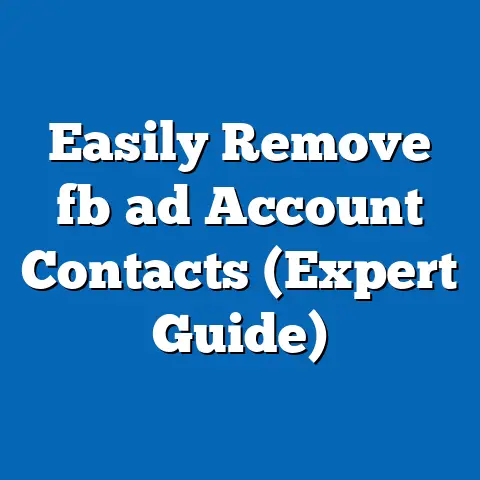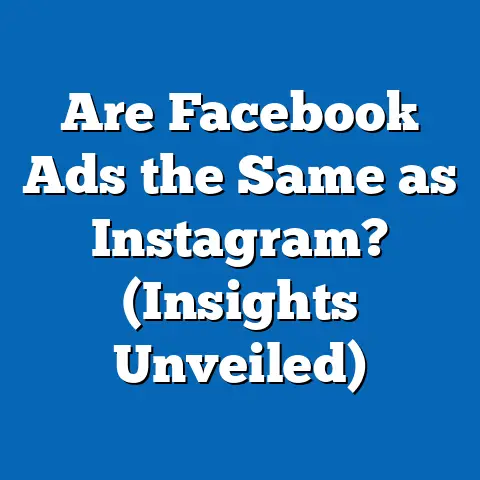Master fb ad Account Exclusions (Unlock Campaign Success)
Imagine Odysseus sailing the seas, his ship battling treacherous currents and his ears filled with the alluring songs of the Sirens. He knew that to reach his destination, he needed to navigate carefully, resisting the temptations that could lead him astray. Facebook advertising can feel a lot like that journey. The platform offers incredible reach and targeting capabilities, but without a strategic approach, you can easily find your budget being drained by irrelevant clicks and wasted impressions. That’s where Facebook ad account exclusions come in – they’re your ship’s rudder, guiding you away from the Sirens and towards campaign success.
In my years of experience managing Facebook ad campaigns for businesses of all sizes, I’ve seen firsthand how crucial exclusions are. They’re not just a nice-to-have feature; they’re a fundamental element of a successful advertising strategy. Think of it this way: you wouldn’t want to waste your time and resources trying to sell snow shovels to people living in the desert, right? Exclusions help you avoid those kinds of costly missteps, ensuring that your ads reach the right people at the right time.
Understanding Facebook Ad Account Exclusions
Before we get into the nitty-gritty details, let’s make sure we’re all on the same page about what Facebook ad account exclusions actually are and why they’re so darn important.
Definition and Importance
Facebook ad account exclusions are essentially the reverse of targeting. Instead of telling Facebook who you want to see your ads, you’re telling it who you don’t want to see them. This is done by specifying certain audiences, demographics, interests, or behaviors that you want to exclude from your ad targeting.
Why is this so important? Well, imagine you’re running a campaign to promote a new product to potential customers. Without exclusions, your ads might be shown to:
- Existing customers: They already know about your product and may not need to see the ad.
- People who have already purchased the product: Showing them the ad is a complete waste of money.
- People who are clearly not interested in your product: This could be based on their demographics, interests, or past behavior.
By using exclusions, you can prevent your ads from being shown to these irrelevant audiences, ensuring that your budget is spent on reaching people who are most likely to convert. This leads to:
- Higher ROI: More conversions for the same amount of ad spend.
- Improved ad relevance: Your ads are more likely to resonate with the people who see them.
- Better overall campaign performance: You’ll see improvements in key metrics like click-through rate (CTR), conversion rate, and cost per acquisition (CPA).
In short, exclusions are a critical tool for optimizing your Facebook ad campaigns and maximizing your return on investment. They allow you to be more precise with your targeting, ensuring that your ads are seen by the people who are most likely to be interested in your products or services.
Types of Exclusions
Facebook offers a variety of exclusion options, allowing you to tailor your targeting to your specific needs. Let’s take a look at some of the most common types of exclusions and how you can use them effectively:
- Custom Audiences: This is one of the most powerful exclusion tools available. Custom audiences allow you to upload your own data (e.g., email lists, phone numbers) to create audiences of people who have already interacted with your business. You can then exclude these audiences from your ad targeting.
- Example: You can upload a list of your existing customers and exclude them from a campaign designed to attract new customers.
- Lookalike Audiences: Lookalike audiences are based on your existing custom audiences. Facebook uses its data to find people who are similar to your best customers or website visitors. You can then exclude these lookalike audiences from your targeting if you want to focus on reaching completely new prospects.
- Example: You can create a lookalike audience based on your existing customer list and exclude it from a campaign designed to re-engage inactive users.
- Specific Demographics: Facebook allows you to exclude people based on their age, gender, location, education level, relationship status, and other demographic factors.
- Example: If you’re selling products targeted towards women, you can exclude men from your ad targeting.
- Behavioral Exclusions: This allows you to exclude people based on their online behavior, such as their purchase history, device usage, and travel habits.
- Example: If you’re promoting a luxury travel package, you can exclude people who have recently purchased budget travel options.
- Interest-Based Exclusions: You can exclude people based on their declared interests on Facebook.
- Example: If you’re promoting a vegan cookbook, you can exclude people who have expressed interest in meat-related topics.
- Example: You can upload a list of your existing customers and exclude them from a campaign designed to attract new customers.
- Example: You can create a lookalike audience based on your existing customer list and exclude it from a campaign designed to re-engage inactive users.
- Example: If you’re selling products targeted towards women, you can exclude men from your ad targeting.
- Example: If you’re promoting a luxury travel package, you can exclude people who have recently purchased budget travel options.
- Example: If you’re promoting a vegan cookbook, you can exclude people who have expressed interest in meat-related topics.
My Experience: I once worked with a client who was running a Facebook ad campaign to promote a new mobile app. Initially, they were targeting a broad audience based on age and location. However, after analyzing their campaign data, we realized that a significant portion of their ad spend was being wasted on users who were already using the app. By creating a custom audience of existing app users and excluding them from the campaign, we were able to dramatically improve their ROI and increase their user acquisition rate.
Takeaway: Understanding the different types of exclusions available on Facebook is crucial for creating effective ad campaigns. By strategically excluding irrelevant audiences, you can ensure that your budget is spent on reaching the people who are most likely to convert.
The Impact of Exclusions on Ad Performance
Now that we’ve covered the basics of Facebook ad account exclusions, let’s take a closer look at how they can impact your ad performance.
Reducing Wasted Ad Spend
One of the most significant benefits of using exclusions is that they can help you reduce wasted ad spend. As I mentioned earlier, without exclusions, your ads may be shown to people who are already customers, who have already purchased your product, or who are simply not interested in what you have to offer. This can quickly drain your budget and lead to a low ROI.
By excluding these irrelevant audiences, you can ensure that your ads are only shown to people who are likely to be interested in your products or services. This can lead to:
- Lower cost per click (CPC): When your ads are more relevant to the people who see them, they’re more likely to click on them, which can lower your CPC.
- Lower cost per acquisition (CPA): By reaching a more targeted audience, you’re more likely to generate conversions, which can lower your CPA.
- Higher conversion rate: When your ads are shown to the right people, they’re more likely to convert into customers.
Statistics: According to a study by HubSpot, businesses that use Facebook advertising see an average ROI of $3.80 for every $1 spent. However, this ROI can be significantly higher if you use exclusions to optimize your ad targeting.
Real-World Example: I worked with a client who was running a campaign to promote a new online course. They were targeting a broad audience of people interested in the course topic. However, after analyzing their campaign data, we realized that a significant portion of their ad spend was being wasted on people who had already taken the course. By creating a custom audience of past students and excluding them from the campaign, we were able to reduce their CPA by 40% and increase their conversion rate by 25%.
Enhancing Audience Targeting
In addition to reducing wasted ad spend, exclusions can also help you enhance your audience targeting. By excluding certain audiences, you can narrow down your targeting to focus on the people who are most likely to be interested in your products or services.
This can lead to:
- Improved ad relevance: When your ads are more relevant to the people who see them, they’re more likely to engage with them.
- Higher click-through rate (CTR): A higher CTR indicates that your ads are resonating with your target audience.
- Better quality leads: By reaching a more targeted audience, you’re more likely to generate high-quality leads that are more likely to convert into customers.
The Role of Data Analysis: To effectively enhance your audience targeting with exclusions, it’s crucial to analyze your campaign data and audience insights. This will help you identify which segments of your audience are not performing well and which segments are most likely to convert.
How to Analyze Data:
- Facebook Ads Manager: Use the Facebook Ads Manager to track key metrics like CPC, CPA, CTR, and conversion rate.
- Facebook Analytics: Use Facebook Analytics to gain insights into your audience’s demographics, interests, and behavior.
- A/B Testing: Experiment with different exclusion options to see which ones perform best.
Expert Insight: “Exclusions are not just about preventing your ads from being shown to the wrong people; they’re also about refining your targeting to reach the right people more effectively,” says Neil Patel, a renowned digital marketing expert. “By analyzing your campaign data and audience insights, you can identify which segments of your audience are most likely to convert and then use exclusions to focus your ad spend on those segments.”
Takeaway: Exclusions are a powerful tool for enhancing your audience targeting and improving your overall campaign performance. By analyzing your campaign data and audience insights, you can identify which segments of your audience are not performing well and then use exclusions to focus your ad spend on the people who are most likely to convert.
Crafting a Strategic Exclusion Plan
Now that you understand the importance of Facebook ad account exclusions and how they can impact your ad performance, let’s dive into how to craft a strategic exclusion plan.
Identifying Exclusion Criteria
The first step in crafting a strategic exclusion plan is to identify the criteria you’ll use to exclude audiences from your ad targeting. This will depend on your specific business goals, target audience, and the nature of your products or services.
Here are some common criteria to consider:
- Existing Customers: If you’re running a campaign to attract new customers, you’ll want to exclude your existing customers. You can do this by creating a custom audience of your customer list and excluding it from your targeting.
- Past Purchasers: If you’re promoting a specific product or service, you’ll want to exclude people who have already purchased it. You can do this by creating a custom audience of past purchasers and excluding it from your targeting.
- Website Visitors: If you’re running a retargeting campaign, you’ll want to exclude people who have already visited your website but haven’t converted. This will help you focus your ad spend on people who are more likely to convert.
- People Who Have Already Engaged with Your Ads: If you’re running a campaign to generate leads, you’ll want to exclude people who have already filled out your lead form or contacted your business. This will help you avoid wasting ad spend on people who are already in your sales funnel.
- Irrelevant Demographics: If your products or services are targeted towards a specific demographic, you’ll want to exclude people who don’t fit that demographic. For example, if you’re selling products targeted towards women, you can exclude men from your ad targeting.
- Irrelevant Interests: If your products or services are related to a specific interest, you’ll want to exclude people who don’t share that interest. For example, if you’re promoting a vegan cookbook, you can exclude people who have expressed interest in meat-related topics.
Reviewing Past Campaign Data: One of the best ways to identify exclusion criteria is to review your past campaign data. This will help you identify which segments of your audience are not performing well and which segments are most likely to convert.
Questions to Ask:
- Which demographics are converting at the highest rate?
- Which interests are generating the most leads?
- Which placements are driving the most conversions?
- Which audiences are costing you the most money without generating results?
My Story: I remember working on a campaign for a local restaurant that was promoting a new lunch special. Initially, we were targeting a broad audience of people who lived within a 5-mile radius of the restaurant. However, after analyzing our campaign data, we realized that a significant portion of our ad spend was being wasted on people who worked in the area but didn’t live there. By excluding people who lived outside of the 5-mile radius but worked within it, we were able to dramatically improve our ROI and increase the number of people who came in for the lunch special.
Implementing Exclusions in Campaigns
Once you’ve identified your exclusion criteria, the next step is to implement them in your Facebook ad campaigns. This is done in the Facebook Ads Manager.
Step-by-Step Guide:
- Create or Edit an Ad Set: Go to the Facebook Ads Manager and create a new ad set or edit an existing one.
- Go to the “Audience” Section: Scroll down to the “Audience” section of the ad set settings.
- Click on “Exclude”: Click on the “Exclude” option.
- Choose Your Exclusion Criteria: Choose the type of exclusion you want to use (e.g., custom audience, demographics, interests, behaviors).
- Select Your Exclusion Options: Select the specific exclusion options you want to use. For example, if you’re excluding a custom audience, select the audience from the dropdown menu.
- Save Your Changes: Save your changes to the ad set.
Visual Aids:
- Include screenshots of the Facebook Ads Manager interface, highlighting the “Exclude” option and the different exclusion criteria.
- Create a short video tutorial demonstrating how to implement exclusions in a Facebook ad campaign.
Testing and Optimizing Exclusions
Implementing exclusions is not a one-time thing. You need to continuously test and optimize your exclusion strategies to ensure that they’re performing effectively.
A/B Testing: One of the best ways to test and optimize your exclusions is to use A/B testing. This involves creating two versions of your ad set, one with exclusions and one without, and then comparing their performance.
Metrics to Track:
- CPC
- CPA
- CTR
- Conversion Rate
- ROI
Analyzing Results: After running your A/B test for a sufficient period of time (e.g., one week), analyze the results to see which version of your ad set performed better. If the version with exclusions performed better, that’s a good indication that your exclusion strategy is working. If the version without exclusions performed better, you may need to re-evaluate your exclusion criteria.
Refining Exclusion Strategies: Based on your A/B testing results, you can refine your exclusion strategies to improve your campaign performance. This may involve adding new exclusions, removing existing exclusions, or adjusting your exclusion criteria.
Takeaway: Crafting a strategic exclusion plan is essential for optimizing your Facebook ad campaigns. By identifying the right exclusion criteria, implementing them effectively, and continuously testing and optimizing your strategies, you can ensure that your budget is spent on reaching the people who are most likely to convert.
Common Mistakes and How to Avoid Them
While exclusions are a powerful tool for optimizing your Facebook ad campaigns, they can also be misused. Here are some common mistakes to avoid:
Over-Excluding Audiences
One of the most common mistakes is over-excluding audiences. This involves excluding too many people from your ad targeting, which can limit your reach and potential conversions.
Risks of Over-Exclusion:
- Limited Reach: When you exclude too many people from your ad targeting, you may not be able to reach enough potential customers.
- Lower Conversion Rate: If you exclude too many people from your ad targeting, you may be left with a small, highly targeted audience that is difficult to convert.
- Higher CPC: A smaller, highly targeted audience can lead to higher competition and higher CPCs.
Example: I saw a campaign where the advertiser excluded anyone who had visited their website in the last 180 days, assuming they weren’t interested. However, this also excluded potential repeat customers who might have been ready to make another purchase.
How to Avoid Over-Exclusion:
- Start with Broad Targeting: When you’re first starting out, it’s best to start with broad targeting and then gradually narrow it down based on your campaign data.
- Use Layered Targeting: Instead of excluding large groups of people, try using layered targeting to reach a more specific audience.
- Monitor Your Reach: Keep a close eye on your reach to make sure that you’re not excluding too many people.
Ignoring Audience Insights
Another common mistake is ignoring Facebook’s audience insights tool. This tool provides valuable information about your target audience’s demographics, interests, and behavior.
Importance of Audience Insights:
- Identify Irrelevant Audiences: Audience insights can help you identify audiences that are not performing well so you can exclude them from your ad targeting.
- Discover New Audiences: Audience insights can also help you discover new audiences that you may not have considered targeting before.
- Improve Ad Relevance: By understanding your audience’s interests and behavior, you can create ads that are more relevant to them.
How to Use Audience Insights:
- Go to Facebook Audience Insights: Go to the Facebook Audience Insights tool in the Facebook Ads Manager.
- Select Your Audience: Select the audience you want to analyze (e.g., your website visitors, your Facebook page fans, a custom audience).
- Explore the Data: Explore the data to learn about your audience’s demographics, interests, and behavior.
Example: I worked with a client who was promoting a new line of organic skincare products. They initially assumed that their target audience was primarily women aged 25-45. However, after analyzing their audience insights, we discovered that a significant portion of their audience was actually men aged 35-55 who were interested in natural and sustainable products. By adjusting their ad targeting to include these men, we were able to increase their sales by 20%.
Neglecting to Update Exclusions
Finally, another common mistake is neglecting to update your exclusions. Your business goals and audience behavior may change over time, so it’s important to review and update your exclusions regularly.
Why Update Exclusions:
- Changing Business Goals: Your business goals may change over time, which may require you to adjust your exclusion strategies.
- Evolving Audience Behavior: Your audience’s interests and behavior may evolve over time, which may require you to update your exclusion criteria.
- New Products and Services: If you launch new products or services, you may need to add new exclusions to your ad targeting.
How to Update Exclusions:
- Set a Reminder: Set a reminder to review your exclusions on a regular basis (e.g., once a month, once a quarter).
- Analyze Your Campaign Data: Analyze your campaign data to identify any areas where you can improve your exclusion strategies.
- Stay Up-to-Date: Stay up-to-date on the latest Facebook advertising trends and best practices.
Takeaway: Avoiding these common mistakes is crucial for maximizing the effectiveness of your Facebook ad account exclusions. By being mindful of these pitfalls and following the tips outlined above, you can ensure that your budget is spent on reaching the people who are most likely to convert.
Advanced Exclusion Techniques
Once you’ve mastered the basics of Facebook ad account exclusions, you can start exploring some more advanced techniques to further optimize your campaigns.
Utilizing CRM Data
One of the most powerful advanced exclusion techniques is to utilize your CRM data. This involves integrating your CRM data with Facebook to create more tailored exclusion strategies.
Benefits of CRM Integration:
- Highly Targeted Exclusions: CRM data allows you to create highly targeted exclusions based on your customer’s purchase history, demographics, and other information.
- Improved Ad Relevance: By excluding people who are already customers or who have already purchased a specific product, you can improve the relevance of your ads.
- Increased Efficiency: CRM integration can help you automate your exclusion strategies, saving you time and effort.
How to Integrate CRM Data:
- Use Facebook’s Custom Audiences: You can upload your CRM data to Facebook to create custom audiences.
- Use a Third-Party Integration Tool: There are several third-party tools that can help you integrate your CRM data with Facebook.
Example: A subscription box company could exclude current subscribers from ads promoting new subscriber sign-ups, focusing instead on re-engaging past subscribers.
Leveraging Retargeting Exclusions
Retargeting is a powerful advertising technique that involves showing ads to people who have already interacted with your business (e.g., visited your website, viewed a product page, added an item to their cart). However, retargeting can also lead to ad fatigue if you’re not careful.
What is Ad Fatigue?
Ad fatigue occurs when people see your ads too many times, which can lead to them becoming annoyed or ignoring your ads altogether.
How to Prevent Ad Fatigue:
- Use Frequency Caps: Set a frequency cap to limit the number of times people see your ads.
- Rotate Your Ads: Rotate your ads regularly to keep them fresh and engaging.
- Use Retargeting Exclusions: Exclude people who have already converted or who have already seen your ads multiple times.
Example: If someone purchases a product after seeing a retargeting ad, you can exclude them from seeing that ad again for a certain period of time.
Seasonal and Event-Based Exclusions
Finally, another advanced exclusion technique is to use seasonal and event-based exclusions. This involves adjusting your exclusions based on seasonal trends or specific marketing events.
How to Use Seasonal and Event-Based Exclusions:
- Analyze Seasonal Trends: Analyze your past sales data to identify seasonal trends.
- Plan Your Exclusions: Plan your exclusions based on the seasonal trends you’ve identified.
- Adjust for Events: Adjust your exclusions based on specific marketing events (e.g., holidays, product launches).
Example: During the holiday season, a retailer might exclude people who have already purchased gifts from their website to focus on reaching new customers.
Takeaway: These advanced exclusion techniques can help you take your Facebook ad campaigns to the next level. By utilizing CRM data, leveraging retargeting exclusions, and using seasonal and event-based exclusions, you can further optimize your ad targeting and improve your campaign performance.
Measuring the Success of Your Exclusion Strategy
Implementing a solid exclusion strategy is only half the battle. You need to be able to measure its success to ensure that it’s actually making a difference.
Key Metrics to Track
There are several key metrics you should track to measure the effectiveness of your exclusion strategies:
- Click-Through Rate (CTR): A higher CTR indicates that your ads are more relevant to your target audience.
- Conversion Rate: A higher conversion rate indicates that your ads are more effective at driving conversions.
- Cost Per Click (CPC): A lower CPC indicates that you’re getting more clicks for your money.
- Cost Per Acquisition (CPA): A lower CPA indicates that you’re acquiring customers more efficiently.
- Return on Ad Spend (ROAS): A higher ROAS indicates that you’re generating more revenue for your ad spend.
Analyzing Campaign Performance
To analyze your campaign performance, you should compare your results before and after implementing your exclusion strategies.
Steps to Analyze Campaign Performance:
- Set a Baseline: Set a baseline by tracking your key metrics before implementing your exclusion strategies.
- Implement Exclusions: Implement your exclusion strategies.
- Track Your Results: Track your key metrics after implementing your exclusion strategies.
- Compare Your Results: Compare your results before and after implementing your exclusion strategies.
How to Use Facebook Ads Reporting Tools:
- Facebook Ads Manager: Use the Facebook Ads Manager to track your key metrics and analyze your campaign performance.
- Facebook Analytics: Use Facebook Analytics to gain insights into your audience’s demographics, interests, and behavior.
My Experience: I once worked with a client who was struggling to generate leads through their Facebook ad campaigns. After analyzing their campaign data, we realized that a significant portion of their ad spend was being wasted on people who were not qualified leads. By implementing a targeted exclusion strategy, we were able to reduce their CPA by 50% and increase their lead quality by 30%.
Takeaway: Measuring the success of your exclusion strategy is crucial for ensuring that it’s actually making a difference. By tracking your key metrics and analyzing your campaign performance, you can identify areas where you can improve your exclusion strategies and further optimize your ad campaigns.
Conclusion: The Path to Campaign Success
Just like Odysseus, you’ve navigated the treacherous waters of Facebook advertising and learned how to resist the allure of wasted ad spend. You now understand the importance of Facebook ad account exclusions and how they can help you achieve your campaign goals. By implementing a strategic exclusion plan, avoiding common mistakes, and leveraging advanced exclusion techniques, you can unlock the full potential of your Facebook ad campaigns.
Remember, mastering ad account exclusions is not just a tactical move; it’s a strategic necessity for unlocking campaign success. It’s about being smart with your budget, reaching the right people, and maximizing your return on investment.
So, embrace exclusions as a fundamental part of your advertising strategy. Experiment with different exclusion options, analyze your campaign data, and continuously refine your strategies. By doing so, you’ll be able to navigate the complexities of Facebook advertising with confidence and achieve the results you’re looking for.
Now, I encourage you to go out there and start experimenting with your own Facebook ad exclusions. Share your experiences and success stories in the comments below. Let’s learn from each other and help each other achieve even greater success with Facebook advertising! What are some of the most effective exclusion strategies you’ve used in your campaigns? What challenges have you faced, and how did you overcome them? Let’s start a conversation and help each other become even better Facebook advertisers.






